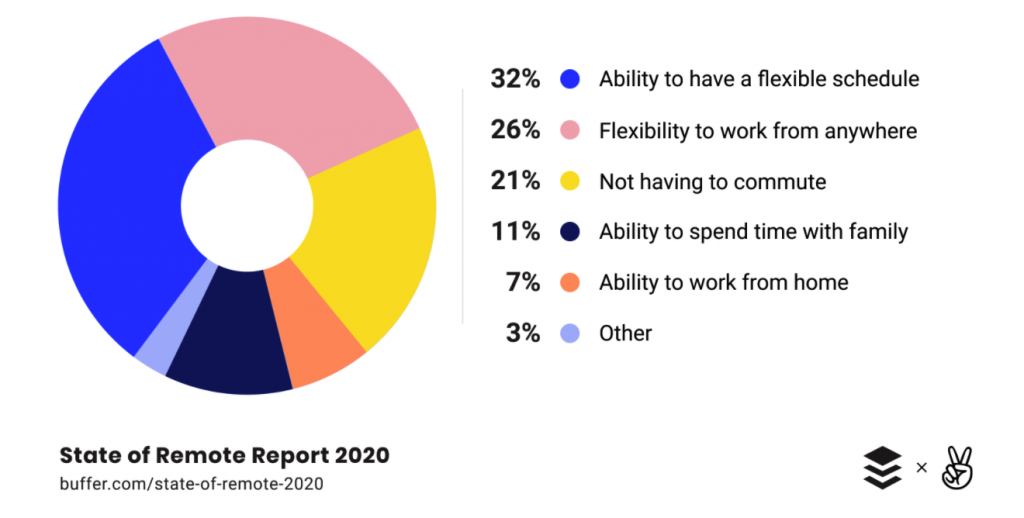
The COVID-19 pandemic forced many businesses to work remote. And as we found out, many employees simply don’t need to work within an office building to be productive — but they do need the right equipment to get the job done efficiently.
Now, in a job-seeker’s environment, many prospective employees want to know if you have work-from-home benefits. Companies that quickly adapt to shifts in the market tend to outperform above those that don’t. So what can you do to get your team ready to work from home? One solution is to adopt a remote office phone system so your team can communicate from anywhere.
Our recent business communications survey reveals that more than 38% of companies have team members who work remotely, and for those who don’t physically come into an office, they are more inclined to communicate with their bosses via email or phone.
So, it’s time to give them what they want — a business phone that can be accessed from anywhere. It’s time to get a remote office phone system for your team.
Let’s dig into the notable features, costs, and compelling benefits you can expect from a remote office phone system:
What should I look for in a remote office phone system? 12 Must-Have Features
Remote work tools and strategies play a significant role in achieving greater flexibility in the workplace. The best way to create a remote office phone system is to start with a quality VoIP phone system.
VoIP phone systems provide users with functionality that was once reserved for advanced call centers. These features are now standard for most modern office phone systems.
Here are the top 12 must-have VoIP features you should look for when choosing a remote office phone system:
- Automatic call distribution – If you run any type of call center, like a customer service or customer support call center, automatic call distribution (ACD) is your best friend. With ACD, you can set rules and criteria so incoming calls automatically get distributed and directed to available extensions or groups.
- Auto-attendant – Third-party VoIP phone systems make calls more efficient and professional with an auto attendant. A virtual assistant greets callers with a menu and routes them to an extension or a local number.
- Caller ID – Nothing about working off-site should involve a guessing game. Caller ID lets remote agents see who’s calling even when they’re away from their business telephone.
- Call forwarding – If an agent receives an incoming call and they are away from their business phone, they can receive calls on their cell phone. This feature and call transfer make the transition quick and seamless.
- Call queuing – Automatic call queuing puts callers on hold when your team is busy. In the event of high call volumes, this feature lowers the chances of callers hanging up. It’s a must if your telephone system receives a spike of calls.
- Visual voicemail – Standard voicemail systems are helpful and straightforward. However, managing voicemails is inefficient. A remote office phone system lets your team listen to voicemail messages on their computers, play them back using a mobile app, and tend to them quickly.
- Voicemail to email – What’s more efficient than voicemail? A system that automatically transcribes your voicemail and delivers it to your inbox. This capability saves your team time in listening to voicemail messages and improves your response times. Just like an email, they can be forwarded, too.
- Voicemail forwarding – Sometimes it’s the little things that boost concentration in a big way. Consider a typical scenario—a team member receives a call but can’t answer immediately. Use this feature to forward a message to a teammate so you can focus on your project.
- Advanced call management – Your employees might not all be under the same roof, but you can still manage even more effectively. With VoIP, you gain access to more powerful calling features like N-Way calling, conference bridges, and simultaneous ring. All of them can be customized to suit the needs of your office.
- Call analytics – Cloud-based office systems are ideal for aggregating incredible amounts of data. When are your peak call times? Where do calls originate? Tracking the individual and team performance helps you serve your customers better. Call analytics provide objective reports in an easy-to-read dashboard. You can even display metrics and KPIs with your team.
- Call recording – Implement automatic and on-demand call recording to coach your sales and support teams. Business leaders appreciate the increased accountability. Since phone calls are recorded in the cloud, you never need any extra equipment or wires.
- Mobile App – Move beyond the typical office environment by providing your staff with a full-featured mobile app. For a remote team, they never miss a beat with an iPhone or Android app that’s connected to the same business phone system.
How Much Does a Remote Phone System Cost?
It’s a fair question—what will you spend on a remote office phone system?
The price varies (depending on the features you need, it could cost less than $20 per line), but it’s almost always less expensive than a landline setup. There are a few reasons why.
First, you’re not tied to expensive hardware. Hardware-free computer applications, called softphones, are your best option for remote phones. Replacing desk phones helps businesses realize significant savings. Your remote employees can download a softphone app on Android and Apple phones, as well as a desktop program for Mac and Windows computers.
Second, it’s feature-packed. A remote phone system provides many more phone features than a traditional phone line. Since most of these features are typically included for one flat rate, you don’t get hit with surprise fees.
Third, it’s quicker and more cost effective to add new phone lines to your remote office phone system. You won’t need to install extra phone lines and wiring to traditional PBX systems. Adding more VoIP lines is a few clicks away.
Finally, you can save even more with an annual agreement as opposed to month-to-month payments.
When it comes to cost, a VoIP-powered remote office phone system is your best investment. But what about the benefits? How does it compare to a traditional phone system?
Stay connected wherever your work takes you.
Try the #1 remote office phone system today.
What Are the Benefits of a Remote Phone System?
Remote access means flexibility, and flexibility is the key to top-notch customer service. After all, there are as many customers’ needs as there are customers. And the more resources you have, the better equipped your staff will be to meet those needs.

Here are the top benefits your business can see from getting a remote office phone system:
1. Use your office phone number to work from home.
Wondering how you can use your office phone from home? VoIP and a remote office phone system is the solution you need. Now you’re no longer bound to your desk to take a call, a VoIP phone line can accept and receive calls from anywhere you have internet. No need to forward a call from your desk phone, you can take a call from an app and work from anywhere, from anywhere you have internet, that is.
2. Stay Connected with Clients & Co-Workers
When you’re away from the office, it’s almost as if you took a sick day. When you’re not seen, it’s difficult for your team and customers to reach you. A remote phone system lets your team stay online and accessible wherever they work.
For even greater connectivity, a cloud phone system contains a managed directory and address book, so staying in touch hasn’t been easier.
3. Everyone Shares One Office Phone System
When working from home, it can be troublesome to communicate with the rest of the team. With a remote office phone system designed to support remote employees, you won’t have this problem.
When time and money are on the line, you don’t want to track down personal cell phones. With one VoIP phone system, call forwarding keeps your team connected in and out of the office.
Virtual PBX systems also provide local and toll-free numbers. PBX systems let employees stay accessible by using their office extensions.
4. On-The-Go Availability
Working from home is very different from working in an office setting. Remote workers often have more control over their schedules, especially if they travel.
The prevailing benefit here is that an office phone system never sacrifices features if employees are away from the office. With a reliable business phone app, employees can access their phone line from any computer or smartphone. All that’s needed is an internet connection — it can work adequately even over Wi-Fi.
Remote employees shouldn’t have to risk missing important phone calls while they’re on the go. Mobility strengthens your business by ensuring that agents are reliable on every device.
5. Voice & Video Conferencing
Communication is the core of every successful team. From the Fortune 500 to the Navy SEALS. Establishing a regular cadence and trust in team communication is what makes them successful.
You can’t leave conversations up to interpretation. Speaking to your team live through the power of video and delivering a presentation live is invaluable. It allows for quick clarifications and the expression of tone and nuance. It even strengthens your remote team overall.
If you find that members of your office jump between different apps to talk, it’s ripe for a communications crisis. To stay focused, limit the number of moves it takes to complete simple tasks such as when chatting with your team.
A remote office phone system provides unified communications that make it easy to switch between voice, video, chat, and email. No matter the situation, your team is covered.
Look for video capabilities that offer one-to-one video chats as well as screen sharing. These functions supplement the day-to-day routines shared by managers and their reports. Personal apps like Skype or Google Hangouts don’t cut it for business.
At the end of the day, you don’t want uncertainty. Video conferences are ideal for presentations, sales pitches, or product demos.
6. Staying Organized & Focused
Did you know that a cloud phone system helps maintain a productive working environment? It’s the unsung hero of the office. With a remote team, your phone system needs to be there to help them stay organized and productive.
With an always updated company directory, employees can find each other and strike up a conversation. This saves time in solving customer questions and invites more direct communication.
Likewise, when it’s time for deep focus, your phone system manages your online presence to tell others you’re in a meeting, away, or simply offline.
Either way, you want a phone system that’s easy to use and is widely adopted from day one.
7. Create custom, fine-grained user permissions
How do you protect your company’s phone system from internal error or abuse? With a zero-trust model, you can assign permissions to select VoIP features on an as-needed basis.
User and location-specific permissions provide organizations control over who manages system settings. These security settings let you maintain access to communication features without placing your business continuity at risk.
IT leaders can breathe a little easier knowing their phone system is hosted in the cloud, making it resilient to natural disasters and even sabotage.
8. No-maintenance approach to phone system security
It’s crucial to understand how VoIP providers control and maintain all the security protocols of your phone system. This concept means your company doesn’t need to maintain the security infrastructure.
Since your phone system uses VoIP, that means it also uses SIP to establish each phone call and message. Much like how websites secure all traffic between the user and server, your phone system can offer the same functionality.
A powerful remote office phone system lets you activate enhanced call security between users. It results in no extra latency, and you can rest assured that others cannot eavesdrop on the conversation. Call encryption is possible because of Transport Layer Security (TLS) and Secure Real-Time Transport Protocol (SRTP).
Reach out to your VoIP provider to confirm their security settings for your company.
9. Protect Personal Privacy
Even on-site staff communicates with clients and colleagues outside of the office. When this happens, they often use personal contact information for a business call.
Unfortunately, this also invites unwanted contact over a communication channel your company doesn’t manage. People are quite protective when it comes to their personal mobile phone number.
From a business standpoint, these situations can significantly damage credibility. Reaching a client via a personal cell phone or home phone number is unprofessional.
A cloud-based VoIP system separates business phone numbers and personal numbers.
Accessing your email from a home or personal computer is simple enough. Why shouldn’t your business phone system be just as flexible? It’s best if all of your business communications are logged and documented for later reference.
Related: Pros & Cons of Working From Home vs. Working in an Office
How to set up a remote office phone system
1. Test your internet connection to make sure it can support all the VoIP features.
First, you should have an internet connection that can support all the VoIP features that you are interested in. A general rule of thumb is that you need about 100 kbps upload and download per line.
Take this VoIP speed test to see if your internet connection is ready to handle VoIP.
2. Choose a VoIP provider and plan.
Of course, we want you to choose us — Nextiva — are your VoIP service provider, but you should choose a provider that has the features your business needs.
First, consider the most important VoIP features to your business. Knowing your list of preferred features will help you narrow down the best provider for your business.
3. Get a business phone number.
If you already have a business phone number, many VoIP providers can use your existing phone number when they set up your remote office phone system.
If you don’t already have a business phone number, many VoIP providers will include a phone number in your package. All you need to know to get a business phone number is what type of number you want — local, toll free, vanity, or virtual.
4. Set up your remote office phone.
Once you have a provider and hardware, it’s time to complete the setup in your office. The specific steps depend on hardware and the number of employees. Check out this video from Nextiva with all the details.
The Future of the Remote Office Phone System
As employees become location-agnostic, so will a company’s phone system. Business leaders will see the proven benefits of a cloud-based phone system.
Companies have already realized the benefits of the cloud. Millions of businesses send and receive email using Google and Office 365, saving them from maintaining costly servers.
Moving to a remote office phone system is the next big move.
Businesses will continue to evolve their technologies and platforms to support their employees. Upwork projects that by 2028 nearly three-fourths of employers will have a remote team.
One example of this dramatic change is the fax machine. Once considered a staple of the typical office is now quite rare. Today, you can send and receive faxes using an online faxing service just like email. Online faxing saves businesses from bulky hardware, toner, and improves internal workflow.
Maintaining versatility in your telecommunications helps businesses prepare for unforeseen circumstances. Moving your phone system to the cloud will help your organization innovate and withstand any changes in the market.
Future-proof your office.
Discover why remote teams choose Nextiva.

Gaetano DiNardi is the Director of Demand Generation at Nextiva and has a track record of success working with brands like Major League Baseball, Pipedrive, Sales Hacker and Outreach.io. Outside of marketing, Gaetano is an accomplished music producer and songwriter – he’s worked with major artists like Fat Joe, Shaggy and loves making music to stay turbocharged. To get in touch, follow him on LinkedIn.
